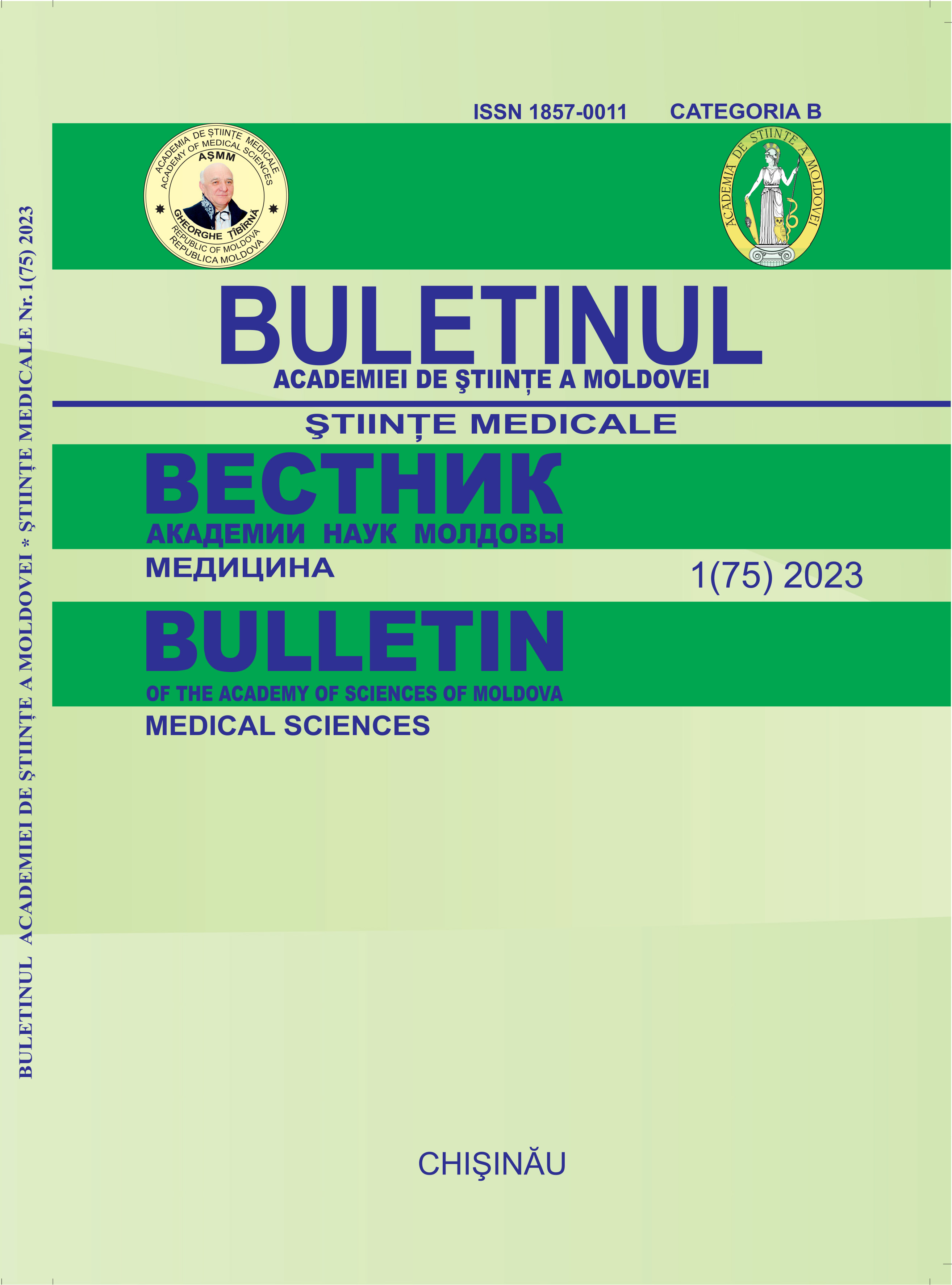TROMBOEMBOLIA ARTEREI PULMONARE - ASPECTE SPECIFICE LA FEMEI
DOI:
https://doi.org/10.52692/1857-0011.2023.1-75.14Cuvinte cheie:
embolia pulmonară, particularități la femeiRezumat
În articol sunt prezentate datele din literatură privind aspectele specifice ale emboliei pulmonare acute la femei. S-a constatat că incidența generală a EP ajustată în funcție de vârstă și sex este mai mare la bărbați, totuși, riscul la femeile în vârstă l-a depășit pe cel al bărbaților de vârstă similară. Factorii de risc pentru EP la femei au inclus vârsta, afecțiunile reumatologice, terapia de substituție hormonală sau utilizarea contraceptivelor orale, sarcina și perioada postpartum, intervenții chirurgicale recente, imobilizarea, traumatisme, obezitate și insuficiență cardiacă. Femeile cu EP au tendința de a fi mai în vârstă, prezintă mai des la internare dispnee, hipotensiune arterială și semne de disfuncție ventriculară dreaptă și au niveluri mai mari de NT-proBNP în comparație cu bărbații. S-a dovedit că în cazurle cu EP sever femeile sunt supuse mai rar trombolizei. Complicațiile hemoragice majore au fost urmărite mai frecvent la femei. Nu s-au găsit diferențe bazate pe sex în ceea ce privește mortalitatea în spital și mortalitatea de toate cauzele la 30 de zile. Datele cu privire la mortalitatea pe termen lung în funcție de gender sunt limitate. Acest articol face parte din cadrul proiectului de stat cu cifrul 20.80009.8007.28
Referințe
Konstantinides SV., Meyer G., Becattini C., et al 2019 ESC Guidelines for the diagnosis and management of acute pulmonary embolism developed in collaboration with the European Respiratory Society: The Task Force for the diagnosis and management of acute pulmonary embolism of the European Society of Cardiology (ESC). European Heart Journal, 2020; 41:543–603
Willich SN., Chuang LH., van Hout B., et al Pulmonary embolism in Europe Burden of illness in relationship to healthcare resource utilization and return to work. Thrombosis Research 2018;170:181-191
Jarman AF, Mumma BE, Singh KS, et al. Crucial Considerations: Sex differences in the epidemiology, diagnosis, treatment, and outcomes of acute pulmonary embolism in non-pregnant adult patients. JACEP Open. 2021;2:e12378
Cohen AT, Agnelli G, Anderson FA, et al. Venous thromboembolism (VTE) in Europe. The number of VTE events and associated morbidity and mortality. Thromb Haemost, 2007;98:756-64.
Barrios D., Morillo R, Guerassimova I., et al. Sex differences in the characteristics and short-term prognosis of patients presenting with acute symptomatic pulmonary embolism. PLoS ONE 2017; 12: e0187648.
Bakebe A., Kashongwe I., Mulenga C., et al. Pulmonary embolism: Epidemiological data and diagnosis in Kinshasa hospitals. Int. J. Tuberc. Lung Dis. 2017; 21: 875–879
Verso M., Agnelli G., Ageno W., et al. Long-term death and recurrence in patients with acute venous thromboembolism: The MASTER registry. Thromb. Res. 2012; 130: 369–373.
Pribish A.M., Beye, S.E, Krawisz A.K., et al.. Sex differences in presentation, management, and outcomes among patients hospitalized with acute pulmonary embolism. Vasc. Med. 2020; 25: 541–548.
Tanabe Y. Yamamoto T., Murata T., et al. Gender Differences Among Patients With Acute Pulmonary Embolism. Am. J. Cardiol. 2018; 122:1079–1084.
Keller K., Rappold L., Gerhold-Ay A., et al. Sex-specific differences in pulmonary embolism. Thromb. Res. 2019; 178:173–181
Choi W.I., Jo J.Y., Kwon Y.S, et al. Incidence of pulmonary embolism among hospitalized patients. Thromb. Res. 2012; 129: 523–525.
Kitamukai O., Sakuma M,; Takahashi T., et al. Incidence and characteristics of pulmonary thromboembolism in Japan 2000. Intern. Med. 2003; 42:1090–1094
Tagalakis V., Kondal D., Ji Y., et al. Men had a higher risk of recurrent venous thromboembolism than women: A large population study. Gend. Med. 2012; 9:33–43.
van Hylckama VA, Helmerhorst FM, Vandenbroucke JP, et al. The venous thrombotic risk of oral contraceptives, effects of oestrogen dose and progestogen type: results of the MEGA case-control study. BMJ 2009;339:b2921
Tepper NK, Whiteman MK, Marchbanks PA, et al. Progestin-only contraception and thromboembolism: a systematic review. Contraception 2016;94:678-700
de-Miguel-Diez J., López-de-Andrés A.,Hernandez-Barrera, V., et al. The significance of heart failure in hospitalised patients with pulmonary embolism. A gender-specific analysis. Int. J. Clin. Pract. 2021; 75: e14558
Thachil R., Nagraj S., Kharawala A.;et al. Pulmonary Embolism in Women: A Systematic Review of the Current Literature. J.Cardiovasc. Dev. Dis. 2022; 9: 234-250.
McHugh K.B., Visani L,; DeRosa M., et al. Gender comparisons in pulmonary embolism (results from the International Cooperative Pulmonary Embolism Registry [ICOPER]). Am. J. Cardiol. 2002;89:616–619
Ebadi H., Le Gal G., Carrier A. et al. Differences in clinical presentation of pulmonary embolism in women and men. J. Thromb. Haemost. 2010; 8: 693–698
Stein P.D., Fowler S.E., Goodman L.R., et al.. Multidetector computed tomography for acute pulmonary embolism. N. Engl. J. Med. 2006; 354:2317–2327.
Chen Y.A, Gra B.G., Bandiera G., et al. Variation in the utilization and positivity rates of CT pulmonary angiography among emergency physicians at a tertiary academic emergency department. Emerg. Radiol. 2015; 2: 221–229.
Aggarwal T., Eskandari,A.; Priya G, et al. Pulmonary embolism rule out: Positivity and factors affecting the yield of CT angiography. Postgrad. Med. J. 2020; 96:594–599.
Masotti L, Panigada G, Landini G, et al. Simplified PESI score and sex difference in prognosis of acute pulmonary embolism: a brief report from a real life study. J Thromb Thrombolysis 2016;41:606-612
Wiegers H., van Es J., Pap A.F., et al. Sex-specific differences in clot resolution 3 weeks after acute pulmonary embolism managed with anticoagulants-A substudy of the EINSTEIN-PE study. J. Thromb. Haemost. 2021; 19:1759–1763.
Panigada G., Masotti L,; Rosi C., et al. Thromboembolic burden, prognostic assessment and outcomes of females compared to males in acute pulmonary embolism. Acta Clin. Belg. 2016; 71:142–148.
Barco S., Klok F.A., Konstantinide, S.V., et al. Sex-specific differences in chronic thromboembolic pulmonary hypertension. Results from the European CTEPH registry. J. Thromb. Haemost. 2020; 18:151–161.
Chen T.X., Pudasaini B., Guo J, et al. Sex-specific cardiopulmonary exercise testing indices to estimate the severity of inoperable chronic thromboembolic pulmonary hypertension. Int. J. Chronic Obstr. Pulm. Dis. 2018; 13: 385–397.
Simcox, L.E., Ormesher L., Tower C., Greer, I.A. Pulmonary thrombo-embolism in pregnancy: Diagnosis and management. Breathe 2015; 11:282–289.
Sun S., Diaconescu M., Zhe T, et al. Outcomes of Multidetector Computed Tomography Pulmonary Angiography in Pregnant and Postpartum Women With Suspected Pulmonary Embolism. Can. Assoc. Radiol. J. 2021; 72:512–518.
Zhang L., Chen Y., Liu, et al. Predictive value of D-dimer and analysis of risk factors in pregnant women with suspected pulmonary embolism after cesarean section. BMC Pulm. Med.2021; 21:391
Wang HC., Tsai PS, Li KY., et al. Perioperative risk factors for postpartum pulmonary embolism in Taiwanese Cesarean section women. Asian J. Anesthesiol. 2017; 55:35–40.
Descărcări
Publicat
Număr
Secțiune
##category.category##
Licență
Copyright (c) 2023 Buletinul Academiei de Științe a Moldovei. Științe medicale

Această lucrare este licențiată în temeiul Creative Commons Attribution 4.0 International License.



